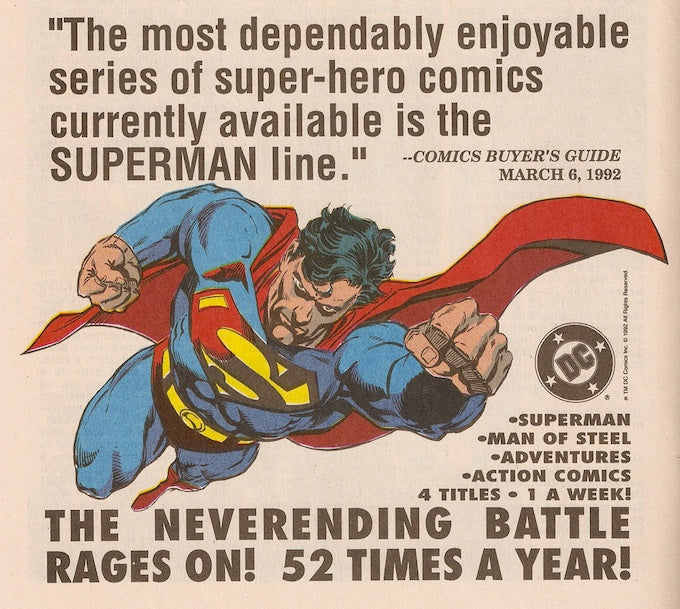
Uncovering the Magic of the Triangle Era of Superman Comics
Share

The Triangle Era of Superman Comics, spanning from 1991 to 2002, marked a defining period in the Man of Steel's history. This era introduced a unique secondary numbering system—a triangle emblem on the cover of each comic—which guided readers through interconnected storylines across *Superman*, *Adventures of Superman*, *Action Comics*, and more. This approach transformed Superman’s world into an immersive, episodic experience, delivering engaging, serialized storytelling that rivaled the best television dramas of its time.
But what made the Triangle Era so impactful? Why do fans of this period still cherish it as one of the best in Superman’s long history? Let’s explore why this era is still revered, and why it’s worth revisiting today.

1. The Birth of the Triangle Era
The Triangle Era officially began with *Superman #51* (1991), but its roots trace back to 1986, post-*Crisis on Infinite Earths*, when DC Comics revamped Superman’s continuity. Under the editorial leadership of Mike Carlin, Superman’s world was reimagined, making the Man of Steel more grounded and relatable. The comics evolved into a continuous narrative, with major storylines like *Exile*, which explored Superman’s guilt and self-imposed exile from Earth, building the foundation for what would later become the Triangle Era.
The triangle numbering system emerged to simplify reading order for fans, as Superman’s adventures often spanned multiple titles. What started as a tool for organization quickly transformed into something much bigger—a cohesive, interconnected universe of stories that allowed for deep character development and long-form storytelling.

2. Superman’s Supporting Cast Shines
One of the greatest strengths of the Triangle Era was its rich supporting cast. Characters like Lois Lane, Jimmy Olsen, Perry White, Cat Grant, and Bibbo Bibbowski were given substantial arcs, adding emotional depth to the narrative. The Kent family also played a crucial role, with Jonathan and Martha Kent advising Clark not only as parents but as trusted confidants who helped him navigate his dual identity as Superman and Clark Kent.
This focus on Superman’s human connections gave readers a reason to stay invested beyond the superheroics. These characters felt like real people with real struggles, making Superman’s world more vibrant and relatable.
3. Lois and Clark: The Relationship We Needed
The Triangle Era also saw the long-awaited romantic progression between Lois Lane and Clark Kent. Their relationship finally advanced, leading to Clark revealing his secret identity and proposing to Lois. This was a monumental shift for the character, as it opened new avenues for storytelling and explored the dynamic of a superhero in a committed relationship.

Lois and Clark’s relationship was a highlight of the era, bringing a fresh perspective to Superman's character. Their love story endured through significant plotlines, even paving the way for future narratives that would later explore them as married parents in DC’s continuity.
4. Major Storylines: From "Panic in the Sky" to "The Death of Superman"
The Triangle Era was home to some of Superman’s most iconic storylines, including *Panic in the Sky*, where Brainiac and Warworld threatened Earth, and the legendary *Death of Superman*, which culminated in one of the most talked-about comic book events of all time. The interconnected nature of the Superman titles allowed for epic story arcs to unfold seamlessly across multiple issues, giving readers a nearly weekly experience that kept them on the edge of their seats.

These major events didn’t just focus on Superman’s battles with villains but also delved into the emotional and psychological tolls of being the world’s greatest hero. The stakes were always high, and the fallout from these events rippled through every aspect of Superman’s world.
5. A Binge-Worthy TV-Like Experience
If graphic novels like *Kingdom Come* and *Birthright* feel like blockbuster films, the Triangle Era reads like a binge-worthy television series. Every issue offered a mix of standalone stories, ongoing subplots, and larger arcs that made the reading experience dynamic and engaging. Fans who invested in the entire lineup of Superman titles were rewarded with a richer, more immersive narrative experience.
6. Artistic Evolution
The Triangle Era also witnessed an artistic renaissance in Superman comics. The post-Byrne years featured distinct artistic styles across each title, from Tom Grummett’s youthful illustrations to Dan Jurgens’ modern takes on the character. Artists like Jon Bogdanove and Jackson Guice added their own flair, making each title feel unique while still contributing to the overarching narrative.
 7. Legacy and End of the Triangle Era
7. Legacy and End of the Triangle EraThe Triangle Era officially ended in 2002, with *Action Comics #785* marking the last issue to carry a triangle number. However, the legacy of this era lives on. It set the standard for interconnected superhero storytelling, influencing future crossover events and shaping the modern comic book industry’s approach to serialized narratives.
Why the Triangle Era Deserves Your Attention
The Triangle Era was a golden age for Superman, blending action, emotion, and rich character development into an unforgettable run. If you’re a fan of long-form storytelling and haven’t explored this period, it’s time to dive in. From Lois and Clark’s romance to epic battles with Lex Luthor and Brainiac, the Triangle Era offers something for every fan of the Man of Steel.
Whether you’re revisiting this classic period or discovering it for the first time, the Triangle Era proves why Superman is not just a symbol of hope but a character capable of deeply resonant, complex storytelling.


